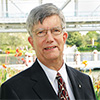Download PDF

By Richard P. Mills, MD, MPH, Chief Medical Editor, EyeNet
Macbeth, the protagonist in Shakespeare’s famous play, intones portentously:
“Tomorrow, and tomorrow, and tomorrow
Creeps in this petty pace from day to day,
To the last syllable of recorded time … ”
The listener is uncertain whether the meaning is the inexorability of time, the fact that time exists only to chronicle the past, or the slow passage toward the denouement—but in any case, its metronomic progression is unmistakable. Edgar Allan Poe provides another such example in his poem “The Bells”:
Keeping time, time, time,
In a sort of Runic rhyme,
To the tintinnabulation that so musically wells,
From the bells, bells, bells …
Another feature of time is the fact that it cannot be manufactured and, hence, cannot be made in excess, to be sold or bartered as a commodity. Each of us is provided our own aliquot of time to use as we wish, and once the time has passed, it is gone forever. Expressions such as borrowing time or saving time or wasting time refer to the activity accomplished during a given stretch of time rather than any ability we have to modify it or get more, as one would go to a cash machine.
Time is often referred to as the fourth dimension of space to be added to the 3-dimensional coordinates of objects, necessary to bring order to our world. But to astrophysicists, our conventional thinking about time is confusing. They have adopted the term “space-time” to denote the difference. Anything beyond that teaser is past the scope of this editorial and way past my personal competence.
So let us consider the concept of time—call it clock-time—as we use it in everyday life. It provides sequence to our experience and a ready catalogue for our memory circuits. We divide it (arbitrarily) into smaller units: the year, the day, the hour, minute, second … and now we’re down to femtosecond and smaller still. (Expensive lasers tend to come in little, short firing packages, I’ve noticed lately.) Note that fudge factors have to be added to some of the units in order to have everything balance out in the end. Leap year is the most familiar example, but there are others. These fudge factors underscore the fact that the human construct of time is arbitrary and works only because everyone is willing to follow its rules.
Most of my career, I have been chronically short of time. The activities I had planned were simply too much to fit into a day. When an ophthalmologist, for example, is in a state of chronic time shortage, it causes stress and anxiety, with an additional feeling of helplessness that the situation is not going to get better. Several strategies beckon. Multitasking is one increasingly popular option, but driving or walking while texting or during hands-free phone use is an increasing collision threat on our roads and sidewalks. Another is delegation, assigning tasks to others in order to protect time promised to friends and family. Another is simply to disenroll from some activities because one’s plate is too full.
Time has a central position in most people’s lives. In fact, our slavish devotion to time implies that time is actually ruling our lives. But if clock-time is simply a human invention, why are we so driven by it? Indeed, shouldn’t it be the other way around? Shouldn’t we be able to unplug from the pressures of time since we brought them on ourselves? The question is worth some meditation.